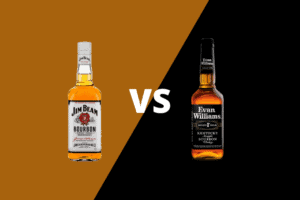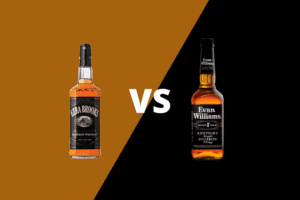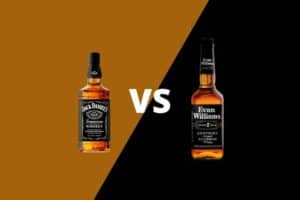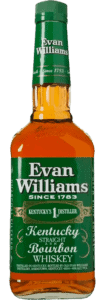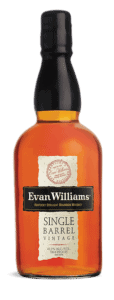There are a few reasons you may have entered ‘Evan Williams Black Label vs Green Label’ into a search engine.
Maybe you’re a customer at the bar who just saw the barkeep pour a bottle with an unfamiliar green label into your cocktail. You could be a bartender or on-premise bar manager looking to further your distilled spirits training. Or maybe you are a bargain-bin bourbon shopping Jedi who has come across this hard-to-find gem.
Evan Williams is one of the most well-known whiskey brands in the world. It is the No. 2 bourbon behind Jim Beam in sales volume in both the U.S. and international markets. But when it comes to its green label extension, there’s not that much information out there to find.
If you come across a bottle in the wild, you might find yourself flummoxed.
In this post, we’ll look behind those labels to compare and contrast Evan Williams’ well-known black label with its lesser-known brother in green. That way, you’ll be able to impress friends and acquaintances if you encounter this bottle in its natural habitat – your favorite whiskey bar or bottle shop.
Table of Contents
History
In our previous versus articles, we usually look at two brands side-by-side to check out brand attributes like history, mash bill, production techniques and maturation and see how they stack up. Naturally, we’re going to have to break the mold a little bit to look at two offerings that come from the same brand — but it does offer us the opportunity to dive deeply into some of these topics.
The Evan Williams brand is named after the historical figure, who immigrated to the United States from Wales at the end of the 18th century and opened Kentucky’s first legal distillery in 1783.
Evan Williams chose a site on the Ohio River to build his distillery. The river offered a ready source of water — essential to any distiller — and a source of transportation to bring his goods to market. Merchants could ship whiskey down the Ohio and Mississippi rivers to the port of New Orleans on the Gulf of Mexico, where it could be distributed across the U.S. coast.
During the journey down the Mississippi, whiskey was transported in wooden barrels. American oak barrels were the shipping container of choice during the 18th century. Made from the abundant lumber of the frontier, they could be used to store both solids and liquids, stacked during the journey, rolled up and down ramps to prevent lifting or the need for mechanical cranes or pulleys and could be reused multiple times. A barrel could be used to store almost anything — from wrought iron nails to milled flour or preserved fish. Because they were reused, whiskey distillers and merchants sometimes performed barrel charring — exposing the inside of the wooden staves to fire — before filling to remove any unwanted flavor influence from the barrel’s previous inhabitant.
Most historians credit these river journeys as the origin of the use of charred oak in bourbon maturation. After receiving goods in New Orleans, merchants and riverboat crews marveled at how the smooth, mellow spirit inside improved during the journey in oak barrels.
Mash Bill
By law, all bourbon must be made of at least 51 percent corn. The mash bill — or list of grain ingredients — for Evan Williams includes about three-quarters corn, with nearly equal proportions of malted barley and rye.
This high proportion of corn is relatively common in the bourbon industry. It enables some of the corn sweetness in the grain to make its way into the finished distilled product.
Both Evan Williams’ green and black label expressions have the term ‘sour mash’ on the label. This describes an old-school technique of fermentation that pulls a portion of terminal beer from the last fermentation to start the next mash. Before distillers understood how yeast operated on a cellular level, the sour mash technique offered a way to control consistency from batch to batch.
Maturation
By law, all bourbon must be matured in new American charred oak barrels.
Both Evan Williams black and green are labeled as ‘Kentucky Straight Bourbon Whiskey,’ a term regulated by the U.S. Alcohol and Tobacco Tax and Trade Bureau. ‘Straight bourbon’ is a legally regulated distinction that means the bourbon has been matured in a new charred American oak barrel for at least two years.
The Evan Williams label includes the term ‘Extra Aged in Oak,’ and Heaven Hill lists the age as “4-5 years old” on the website and other promotional materials. However, these sources are not as strong of a statement as one that appears on the label. The TTB diligently approves the label of each variation of whiskey released in the United States. To use an age statement on the label, a brand must track every barrel and be able to list fill and empty dates for each barrel in the batch. If the label has an age of five years, for example, it tells the customer that each barrel used in that particular blend is at least five years old — with many barrels in that blend likely much older. A claim on the website is not as strong of a statement because we do not know whether the brand is claiming that the ‘4-5 years’ is the flavor profile — how old the whiskey ‘tastes’ — or a specific age statement in relation to every single barrel.
Since both black and green label have the same ‘straight’ designation, we do not know which — if either — is more mature. Without speaking directly to the production team1, we can’t say whether both brands use the same barrels and simply dilutes the green label portion by another six proof points or if it is composed of an entirely different blend of barrels tagged with a particular flavor profile in mind.
Production Techniques
The Evan Williams brand is owned by the Bardstown, Kentucky, based spirits producer Heaven Hill and is produced in their Bernheim Distillery in downtown Louisville.
Heaven Hill, the 5th largest spirits producer in the United States, and the Heaven Hill Distillery is a modern, high-capacity operation. It produces about 1,300 barrels per day.
The massive compound includes numerous rickhouses — the traditional wooden multi-storied warehouses used to mature bourbon — and the company claims the second-largest inventory of aging barrel stock in the world.
Price Point & Value
The main difference between these two Evan Williams products is proof and price.
Evan Williams black label costs about $15 for a 750mL bottle and bottled at 86-proof, or 43 percent alcohol by volume. Black label is considered a Standard segment offering.
[Related: Complete Evan Williams Black Label Bourbon Review]
Evan Williams green label is about $10 for a $750mL bottle and bottled at the legally required minimum 80-proof, or 40 percent ABV. Green label is considered a Value segment offering.
[Related: Complete Evan Williams Green Label Bourbon Review]
Fifteen dollars might not sound like a lot of money for a great bottle of whiskey. In fact, whiskey connoisseurs who may be reading this article likely have paid a lot more. But that extra $5 can make all the difference for a bar owner or manager looking to build a successful drinks portfolio.
As a general rule, most cocktails use the 1.5-ounce jigger as the standard pour. So, a bottling of the same bourbon at a lower price point means the bartender gets the same number of mixed drinks out of the 750mL bottle but with less overhead — and more profit — for each drink.
Evan Williams green label is an enticing offering for bar managers looking for a well-known bourbon brand to build a spirits program.
Tasting Notes
Please note that due to the lack of availability of this product in the author’s area, this post only includes tasting notes for Evan Williams Black Label Bourbon.
Description: In the glass, Evan Williams Black Label has a deep copper color.
Nose: Oak, vanilla, baking spices and leather, with a corn sweetness.
Palate: Stone fruits, baking spices, honey and buttery caramel.
Finish: Butterscotch, a touch of spice from the rye grain, and a peppery spice.
1 Heaven Hill did not respond to a request for comment for this article.














